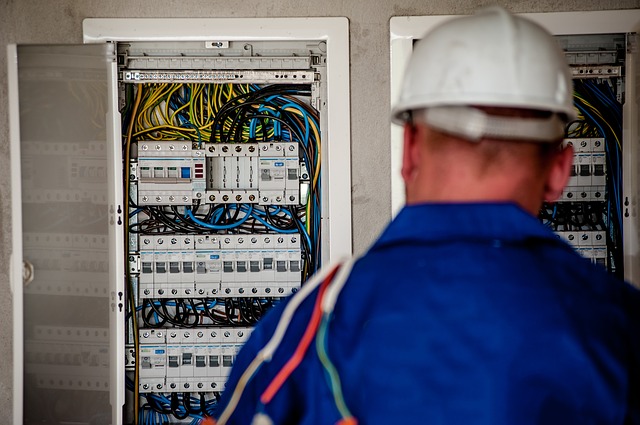Electrical system
Contents |
[edit] Introduction
An electrical system, within the context of a building, is a network of conductors and equipment designed to carry, distribute and convert electrical power safely from the point of delivery or generation to the various loads around the building that consume the electrical energy.
The vast majority of electrical systems used in buildings in the UK operate at 230V single phase alternating current (AC) or 400V 3 phase, at a frequency of 50Hz. These networks are often referred to as low voltage (LV) networks. This system is also referred to as mains electricity.
Larger installations may operate at higher voltages, often with 11kV supplies or feeders at the origin of the installation. These networks are referred to as high voltage (HV) networks.
Power conversion from 11kV networks down to the 230V-400V range is usually undertaken via transformers in a substation.
[edit] Conductors
The conductors that form part of the electrical system are the means by which electricity is transferred from one place to another. Typically, conductors are made from copper, which offers a good balance between electrical conductivity and cost. Aluminium may also be used in some instances. Conductors are typically insulated with PVC or other synthetic insulating materials.
Most conductors are used in the form of electrical cables. These can be run either separately or within containment systems between two points of an electrical system.
Other conductors commonly used in electrical systems in buildings are busbars. These are usually copper or aluminium conductors and run within an insulating and safety enclosure, typically a trunking. These may be used where larger conductors are required, as the busbar trunking is often physically smaller than cables of equivalent current carrying capacity. Such busbar trunking is usually made up of rigid lengths, and may have several tapping points, where supplies may be tapped or branched off.
[edit] Switchgear
As well as conductors, an electrical system will also comprise equipment that provides switching and protection capabilities, known as switchgear. Switchgear enables with manual or automated control of current flow.
Manual control relies on human intervention to work smoothly and is typically employed for isolation switching and functional switching.
Automatic switching may be based on protection characteristics for devices that detect excess current flow and act to prevent damage to cabling that may lead to fire and/or electric shock. This is usually achieved through the use of circuit breakers and/or fuses.
Automatic switching may also be handled by control systems, where electrical signalling from other systems is used to control devices known as relays or contactors, which in turn control higher power circuits.
[edit] Load devices
The final components of an electrical system are referred to as load devices. These convert electrical energy into other forms of energy such as heat, light, or movement.
Examples of these include common items such as light fittings (luminaires), motors, electric heating units, as well as power conversion equipment which converts mains electricity to lower voltages to run appliances and electronic equipment. Often such power conversion is done within the appliance or load itself.
--ECA
[edit] Related articles on Designing Buildings Wiki
- Articles about electricity.
- BEAMA.
- Competition and the independent electric wholesalers.
- ECA articles.
- Electric.
- Electrical appliance.
- Electrical consumption.
- Electrical energy.
- Electrical equipment.
- Electrical installation.
- Electrical power.
- Electrical safety.
- Electrician.
- Electricity bill.
- Mains electricity.
Featured articles and news
The UK's Modern Industrial Strategy: A 10 year plan
Previous consultation criticism, current key elements and general support with some persisting reservations.
Building Safety Regulator reforms
New roles, new staff and a new fast track service pave the way for a single construction regulator.
Architectural Technologist CPDs and Communications
CIAT CPD… and how you can do it!
Cooling centres and cool spaces
Managing extreme heat in cities by directing the public to places for heat stress relief and water sources.
Winter gardens: A brief history and warm variations
Extending the season with glass in different forms and terms.
Restoring Great Yarmouth's Winter Gardens
Transforming one of the least sustainable constructions imaginable.
Construction Skills Mission Board launch sector drive
Newly formed government and industry collaboration set strategy for recruiting an additional 100,000 construction workers a year.
New Architects Code comes into effect in September 2025
ARB Architects Code of Conduct and Practice available with ongoing consultation regarding guidance.
Welsh Skills Body (Medr) launches ambitious plan
The new skills body brings together funding and regulation of tertiary education and research for the devolved nation.
Paul Gandy FCIOB announced as next CIOB President
Former Tilbury Douglas CEO takes helm.
UK Infrastructure: A 10 Year Strategy. In brief with reactions
With the National Infrastructure and Service Transformation Authority (NISTA).
Ebenezer Howard: inventor of the garden city. Book review.
The Grenfell Tower fire, eight years on
A time to pause and reflect as Dubai tower block fire reported just before anniversary.
Airtightness Topic Guide BSRIA TG 27/2025
Explaining the basics of airtightness, what it is, why it's important, when it's required and how it's carried out.
Construction contract awards hit lowest point of 2025
Plummeting for second consecutive month, intensifying concerns for housing and infrastructure goals.
Understanding Mental Health in the Built Environment 2025
Examining the state of mental health in construction, shedding light on levels of stress, anxiety and depression.























